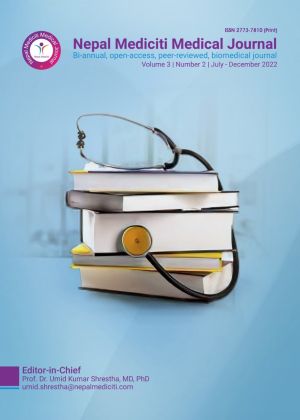Intramedullary Spinal Cord Tumors (IMSCTs): Outcome after surgical resection in 35 cases and review of literature
DOI:
https://doi.org/10.3126/nmmj.v3i2.52345Keywords:
Intramedullary spinal cord tumor, surgical resection, outcomeAbstract
BACKGROUND Intramedullary Spinal Cord Tumors (IMSCTs) are rare and they represent only 5% of all spinal tumors. Ependymoma and astrocytoma are two most common IMSCTs. Due to recent advances in micro instruments, imaging and technology, aggressive surgical excision has become a safer possibility with better outcome. Aim of this study is to analyze functional outcome of patients after surgical resection of IMSCTs and review of literature.
METHODOLOGY Over a period of 4 years, between May 2017 and January 2021, 35 patients were operated for IMSCTs under general anesthesia. Neurophysiological monitoring (NPM) was recently available and used only in last few cases. CUSA was used whenever required in these microsurgical procedures. This retrospective study was carried out after retrieving data from OT registers, inpatient files, OPD records, and statistical analysis was executed using SPSS software (version 18). Functional outcome was assessed by McCormick grading scale and mean follow up period was 2.5 years.
RESULTS Out of 35 patients, 17 were male and 18 female. Mean age distribution was 27.57(+/-17.68). On admission, 30 patients had motor deficits, 18 had neck or back pain, 10 had sphincter dysfunction, 7 had kyphoscoliosis and 2 patients had normal neurology. MRI with IV contrast of these 35 patients revealed intramedullary lesions at cervical (11), cervicomedullary (4), thoracic (8), cervicothoracic (2), thoracolumbar (3), conus (6) and lumbar (1) regions. 22 patients had gross total and 13 had subtotal resection. Histological examination confirmed 30 glial tumors (ependymoma & astrocytoma), 2 dermoid/epidermoid, 2 neurenteric cysts and 1 secondary. Postoperative complication was 17% and there was no surgery related 30 days’ mortality. Functional outcome was measured by McCormick grade before and after microsurgical resection. Preoperatively 3(8.5%) patients had low grade or independent and 32 (91.4%) had high grade or dependent. Postoperatively and at the time of discharge 14 (40%) of patients had low grade or independent and 21 (60%) were dependent or high grade. On last followed up (4 years) 15 (48.3%) had low grade and 16 (51.6%) had high grade or dependent. In our series, on followed up of 4 years, recurrence rate was 5(14.2%), They were 2 astrocytoma, 1 secondary, and 2 myxopapillary ependymomas. Two patients with myxopapillary ependymoma were operated twice and no radiotherapy was advocated. 8 (22.6%) patients received local radiation and recurrence rate was 17.2%.
CONCLUSION Safe resection of intramedullary lesion is possible with the aid of modern neurosurgical tools, however, functional outcome relies on preoperative neurological status of the patients, extent of excision and histology of tumor. Risk factors for recurrence of IMSCTS are extent of resection and histological behavior of tumor.
Downloads
Downloads
Published
How to Cite
Issue
Section
License
Copyright (c) 2022 Nepal Mediciti Medical Journal

This work is licensed under a Creative Commons Attribution 4.0 International License.
This license enables reusers to distribute, remix, adapt, and build upon the material in any medium or format, so long as attribution is given to the creator. The license allows for commercial use.

